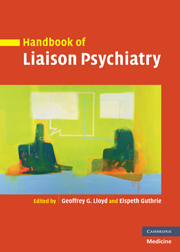Book contents
- Frontmatter
- Contents
- List of contributors
- Preface
- Part I Basic skills
- Part II Common psychiatric problems across the general hospital
- Part III Working with specific units
- 14 Neurological disorders
- 15 Cardiorespiratory disorders
- 16 Gastrointestinal disorders
- 17 Liver disorders
- 18 Endocrine disorders
- 19 Diabetes
- 20 HIV and AIDS
- 21 Renal disease
- 22 Musculo-skeletal disorders
- 23 Oncology
- 24 Head and neck cancer
- 25 Palliative care
- 26 Cosmetic procedures
- 27 Perinatal and gynaecological disorders
- 28 The intensive care unit
- 29 The burns unit
- 30 Psychocutaneous disorders
- 31 Genitourinary disorders
- 32 The emergency department
- Part IV Treatment
- Part V Different treatment settings
- Index
- References
28 - The intensive care unit
from Part III - Working with specific units
Published online by Cambridge University Press: 10 December 2009
- Frontmatter
- Contents
- List of contributors
- Preface
- Part I Basic skills
- Part II Common psychiatric problems across the general hospital
- Part III Working with specific units
- 14 Neurological disorders
- 15 Cardiorespiratory disorders
- 16 Gastrointestinal disorders
- 17 Liver disorders
- 18 Endocrine disorders
- 19 Diabetes
- 20 HIV and AIDS
- 21 Renal disease
- 22 Musculo-skeletal disorders
- 23 Oncology
- 24 Head and neck cancer
- 25 Palliative care
- 26 Cosmetic procedures
- 27 Perinatal and gynaecological disorders
- 28 The intensive care unit
- 29 The burns unit
- 30 Psychocutaneous disorders
- 31 Genitourinary disorders
- 32 The emergency department
- Part IV Treatment
- Part V Different treatment settings
- Index
- References
Summary
Introduction
Intensive care medicine is a relatively new speciality made possible by technological advances in artificial life support. Intensive care unit (ICU) development took its first steps at Copenhagen in 1952, with treatment using positive pressure ventilation of poliomyelitis cases. This success was copied worldwide during similar epidemics and now intensive care units are integral parts of most major acute hospital services.
In the UK there are over 200 ICUs admitting around 80 000 patients per year. Intensive care medicine is able to offer support for those suffering acute multiple organ failure, including pulmonary, haematological, hepatic, cardiovascular and renal replacement therapy. Data derived from the Case Mix Programme of the Intensive Care National Audit and Research Centre (www.icnarc.org) suggest that ICU mortality is high, with only 70% of admissions surviving to hospital discharge. Technological advances have created unique ethical dilemmas for those involved in the ICU, particularly regarding the withdrawal of life-supporting therapy in patients often unable to speak for themselves.
From the 1960s, increasing interest has developed in the psychological impact of the ICU environment. Research and clinical input has been provided by several disciplines: nursing, psychology and psychiatry.
One of the first reviews of the issues from a psychiatric perspective was by Kornfeld in 1969. He categorized the problems into four areas:
psychiatric reactions to the conditions that led to ICU admission
psychiatric reactions provoked by the unusual environment of the ICU
psychiatric reactions that develop post-discharge
the psychological welfare of staff working on ICUs.
In this chapter, the issues are categorized in the same way, but the impact on relatives and approaches to liaison with the ICU are also discussed.
- Type
- Chapter
- Information
- Handbook of Liaison Psychiatry , pp. 673 - 696Publisher: Cambridge University PressPrint publication year: 2007
References
- 2
- Cited by

